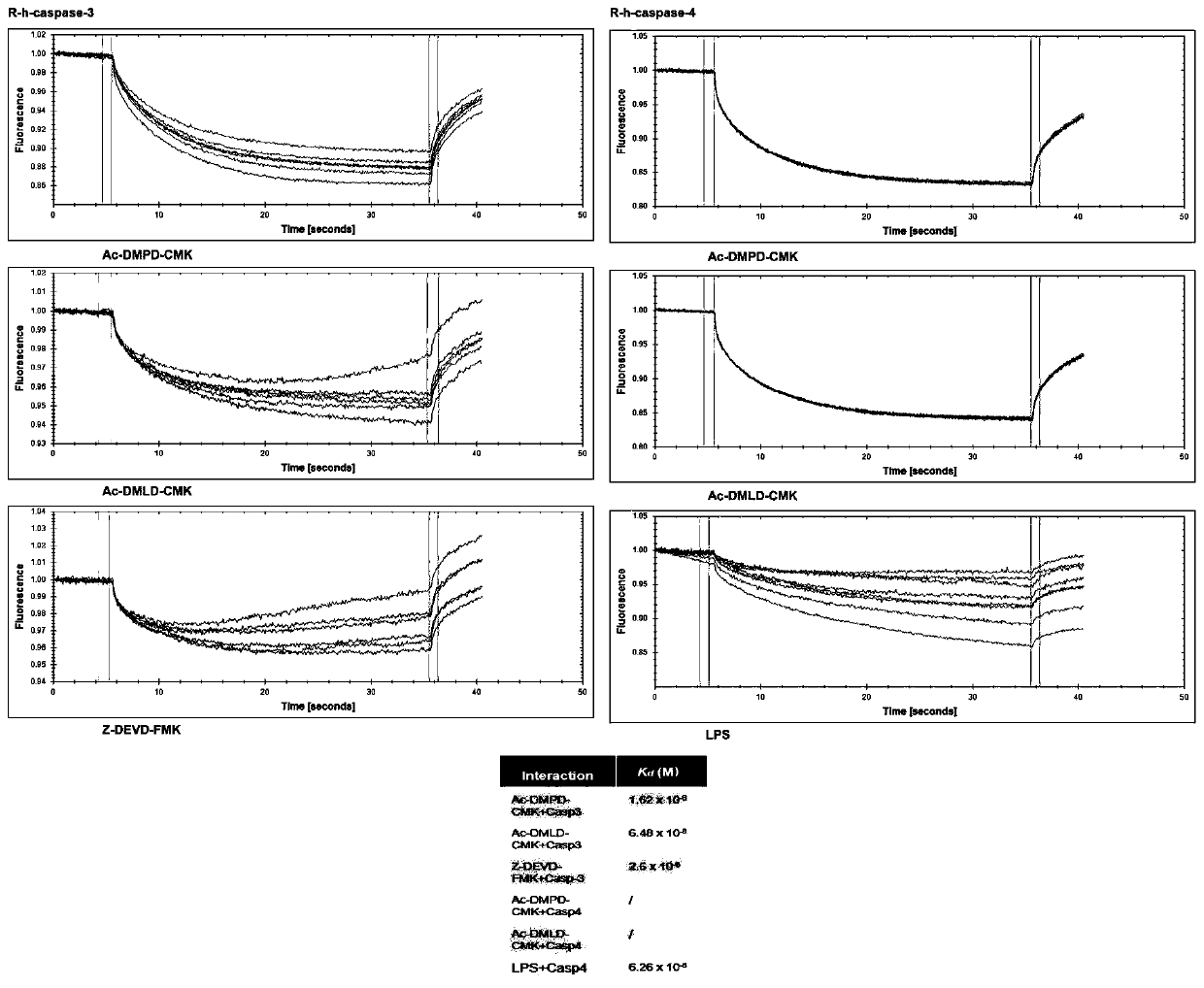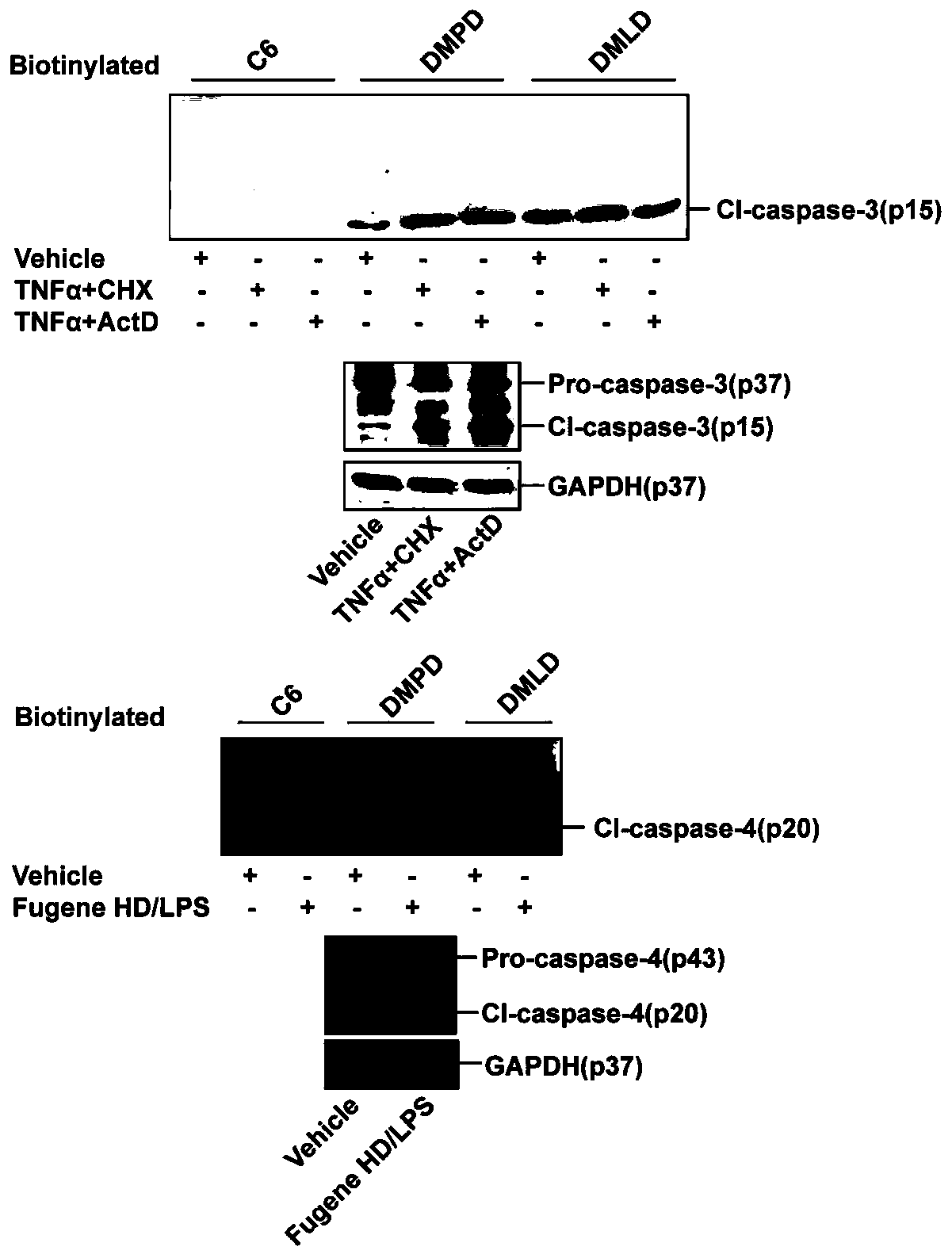Caspase-3 inhibitor and purpose
An inhibitor, aspartic acid technology, is applied in the direction of medical preparations containing active ingredients, tetrapeptide components, digestive system, etc., and can solve problems such as limited application, poor membrane permeability, and unsatisfactory cell effects
- Summary
- Abstract
- Description
- Claims
- Application Information
AI Technical Summary
Problems solved by technology
Method used
Image
Examples
Embodiment 1
[0045] Molecular structural formula of Ac-DMPD / DMLD-CMK (982478 / 982479, China Peptide Biochemical Co., Ltd.). The specific steps of the MST instrument (NanoTemper, Germany) detection are as follows: the concentration gradient of the inhibitor is set to: 0.8, 1.6, 3.2, 6.25, 12.5, 25, 50, 100, 200 μM, and diluted to the above concentration gradient with PBS before use. Dilute the active protein of caspase-3 (Nanjing Jingmai Biotechnology Co., Ltd.) fused with GFP to an appropriate concentration. The peak intensity detected by the microthermophoresis instrument is preferably 200-600 peak intensity. GFP recombinant protein (Nanjing Detai Biotechnology Co., Ltd.) was used as a control to observe whether the interaction between the inhibitor and caspase-3 was specific. Each concentration of inhibitor and protein was mixed at a ratio of 1:1 (4+4μl) for 10 minutes and then tested on the machine. Select blue light as the excitation condition, set the excitation parameters (20%-50%), a...
Embodiment 2
[0073] The inhibitor concentration gradient was set to 1.5, 3.125, 6.25, 12.5, 25, 50, 100 μM, the dosage of active caspase-3 was 1 unit, and the composition of warm compress system was: 50mM HEPES (pH7.5), 150mM NaCl, 3mM EDTA and 0.005% (v / v) Tween-20 and 10mM DTT. Add 1 unit caspase-3 / 4 protein to 100μl reaction system, shake well, then add concentration gradient inhibitors and incubate at room temperature for 2h, then add 200μM corresponding substrate, among which caspase- 3 protein uses Ac-DMPD / DMLD-AMC as the substrate, and caspase-4 (1084, Biovision) uses Ac-LEVD-pNA (1110, Biovision) as the chromogenic substrate. The instrument detects the fluorescence value of caspase-3 activity at Ex 365nm and Em 450nm, and detects the activity of caspase-4 at the absorption wavelength of 405nm. Using Graphpad prism6.0 software in the nonlinear fitting mode log (inhibitor concentration) vs enzyme activity ratio (%) to obtain the IC50 value and the corresponding inhibition curve. Fi...
Embodiment 3
[0076] HepG2 (ATCC, HB-8065) cell level verification of inhibitor efficacy
[0077] First determine the dose and action time of anti-tumor drugs, and found that in the case of 70-80% cell confluency, pre-administered 10 μg / ml cycloheximide CHX or 400nM actinomycin D ActD for half an hour, and then co-administered 20ng After 16 hours of TNFα / ml TNFα treatment, the cells appeared massive necrosis, and the caspase-3, PARP and GSDME proteins were obviously activated after 8 hours. Based on this, the inhibitor concentration gradient was set to 3.125, 6.25, 12.5, 25, 50, 100, and 200 μM. After pre-administrating the HepG2 cell concentration gradient inhibitor for 2 hours, 10 μg / ml CHX or 400 nM ActD was synergistically pre-administered for 0.5 h. In the end, 20ng / ml TNFα was administered synergistically for 16 hours, and the lactate dehydrogenase detection kit (C0017, Biyuntian Biotechnology Co., Ltd.) was used to detect the release of lactate dehydrogenase in the cell culture sup...
PUM
 Login to View More
Login to View More Abstract
Description
Claims
Application Information
 Login to View More
Login to View More - R&D
- Intellectual Property
- Life Sciences
- Materials
- Tech Scout
- Unparalleled Data Quality
- Higher Quality Content
- 60% Fewer Hallucinations
Browse by: Latest US Patents, China's latest patents, Technical Efficacy Thesaurus, Application Domain, Technology Topic, Popular Technical Reports.
© 2025 PatSnap. All rights reserved.Legal|Privacy policy|Modern Slavery Act Transparency Statement|Sitemap|About US| Contact US: help@patsnap.com



